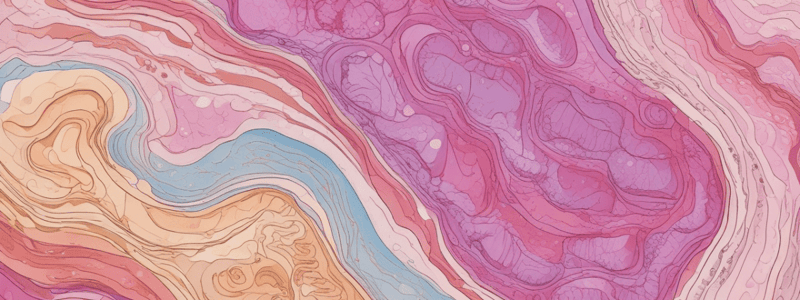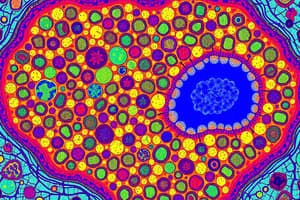Podcast
Questions and Answers
Which type of tissue covers and lines the external and internal body surfaces?
Which type of tissue covers and lines the external and internal body surfaces?
- Connective tissue
- Muscle tissue
- Epithelial tissue (correct)
- Nerve tissue
What characterizes simple epithelium?
What characterizes simple epithelium?
- Composed of a single layer of cells (correct)
- Is primarily made of connective tissue
- Contains tightly packed polyhedral cells
- Consists of multiple layers
What is the basic function of the basement membrane?
What is the basic function of the basement membrane?
- To facilitate muscle contraction
- To provide nerve signaling
- To support and anchor the epithelium (correct)
- To store fat in connective tissue
What is the characteristic of stratified epithelium?
What is the characteristic of stratified epithelium?
How do epithelial cells obtain their nutrition?
How do epithelial cells obtain their nutrition?
Which of the following statements about epithelial tissue is incorrect?
Which of the following statements about epithelial tissue is incorrect?
What type of cartilage is characterized by the presence of numerous elastic fibers in addition to collagen fibers?
What type of cartilage is characterized by the presence of numerous elastic fibers in addition to collagen fibers?
Which cells are responsible for producing the cartilage matrix?
Which cells are responsible for producing the cartilage matrix?
Which type of cartilage is rarely found alone and often merges with neighboring hyaline cartilage?
Which type of cartilage is rarely found alone and often merges with neighboring hyaline cartilage?
What is the main function of cartilage in the embryo?
What is the main function of cartilage in the embryo?
What is interstitial growth in cartilage?
What is interstitial growth in cartilage?
Which of the following statements about bone tissue is true?
Which of the following statements about bone tissue is true?
What is the role of osteoblasts in bone tissue?
What is the role of osteoblasts in bone tissue?
What characterizes compact bone compared to cancellous bone?
What characterizes compact bone compared to cancellous bone?
What type of growth occurs in cartilage when layers are added from the outside of the tissue mass?
What type of growth occurs in cartilage when layers are added from the outside of the tissue mass?
What is the role of osteoblasts in bone histology?
What is the role of osteoblasts in bone histology?
Which cells are considered mature osteoblasts that are trapped in the bone matrix?
Which cells are considered mature osteoblasts that are trapped in the bone matrix?
What is the primary function of blood as a connective tissue?
What is the primary function of blood as a connective tissue?
Which component of blood is primarily responsible for carrying proteins and cells?
Which component of blood is primarily responsible for carrying proteins and cells?
What occurs to serum after clotting proteins are removed?
What occurs to serum after clotting proteins are removed?
Which formed element of blood is primarily responsible for transporting oxygen and carbon dioxide?
Which formed element of blood is primarily responsible for transporting oxygen and carbon dioxide?
What is the primary function of platelets in the blood?
What is the primary function of platelets in the blood?
Which type of muscle tissue is involuntary and found in the heart?
Which type of muscle tissue is involuntary and found in the heart?
Which of the following statements about white blood cells is true?
Which of the following statements about white blood cells is true?
How are red blood cells characterized?
How are red blood cells characterized?
What type of muscle tissue is voluntarily controlled and usually attaches to bones?
What type of muscle tissue is voluntarily controlled and usually attaches to bones?
Which component of blood is derived from stem cells in the bone marrow?
Which component of blood is derived from stem cells in the bone marrow?
Which of the following best describes the structural organization of skeletal muscle?
Which of the following best describes the structural organization of skeletal muscle?
What marks the end of the preimplantation period?
What marks the end of the preimplantation period?
Which layer of the blastocyst is responsible for forming the embryo?
Which layer of the blastocyst is responsible for forming the embryo?
During which week does the primitive streak begin to form?
During which week does the primitive streak begin to form?
What is the result of increased cellular proliferation during the embryonic period?
What is the result of increased cellular proliferation during the embryonic period?
What does the mesenchyme develop into during the embryonic period?
What does the mesenchyme develop into during the embryonic period?
The blastocyst consists of which two main layers?
The blastocyst consists of which two main layers?
What initiates the CNS development in the later part of the 3rd week?
What initiates the CNS development in the later part of the 3rd week?
What is the correct sequence of structures formed from ectoderm during neural development?
What is the correct sequence of structures formed from ectoderm during neural development?
Flashcards are hidden until you start studying
Study Notes
Tissue Histology
- Tissues are classified into four basic histological types: epithelial, connective, muscle, and nerve.
Epithelial Tissue
- Epithelium covers and lines body surfaces, including vessels and cavities.
- Composed of closely packed polyhedral cells with minimal intercellular substance.
- Cells are tightly joined by desmosomes and hemidesmosomes, with no blood vessels (avascular).
- Nutrients diffuse from adjoining connective tissue, and rapid cellular turnover occurs.
Classification of Epithelial Tissues
- Simple Epithelium: Single layer of cells.
- Stratified Epithelium: Two or more layers; only the basal layer contacts the basement membrane.
- Predominantly stratified squamous epithelium in the body.
Rete Ridges
- Extensions of epithelium into connective tissue known as rete ridges or rete pegs.
Basement Membrane
- Thin acellular layer between epithelium and connective tissue.
- Composed of two layers: basal lamina (superficial) and deeper loose connective tissue.
Connective Tissue: Cartilage
- Firm, non-calcified tissue that acts as skeletal support, especially in embryos and joints.
- Avascular tissue relies on neighboring connective tissues (perichondrium) for nutrition.
- Contains no nerve supply.
Histology of Cartilage
- Composed of chondroblasts (cartilage matrix producers) and chondrocytes (mature chondroblasts).
- Three types of cartilage:
- Hyaline Cartilage: Most common, contains only collagen fibers.
- Elastic Cartilage: Contains elastic fibers in addition to collagen.
- Fibrocartilage: Merges with hyaline cartilage and is never found alone.
Cartilage Growth
- Grows via:
- Interstitial Growth: From within the tissue.
- Appositional Growth: Addition of layers from the outer surface.
Connective Tissue: Bone
- Rigid tissue forming most of the mature skeleton.
- Covered by periosteum, which has an outer layer (blood vessels and nerves) and an inner layer (osteoblasts).
Types of Bone
- Compact Bone (Cortical): Dense with few spaces.
- Cancellous Bone (Spongy/Trabecular): Lightweight with many tissue spaces.
- Endosteum: Inner lining of bones, similar to periosteum but thinner.
Histology of Bone
- Bone matrix initially forms as osteoid produced by osteoblasts.
- Osteocytes: Mature osteoblasts trapped in bone matrix; Osteoclasts: Cells responsible for bone resorption.
Connective Tissue: Blood
- Fluid connective tissue that transports cellular nutrients.
- Composed of plasma and formed elements, with plasma being the liquid component.
- Serum: Fluid remaining after clotting proteins are removed.
Formed Elements of Blood
- Red Blood Cells (RBCs): Biconcave disc, no nucleus; contains hemoglobin for oxygen and carbon dioxide transport.
- Platelets (Thrombocytes): Cell fragments, involved in blood clotting.
- White Blood Cells (WBCs): Defense cells, critical for inflammatory and immune responses.
Muscle Tissue
- Comprises the muscular system; muscles contract under neural control causing movement.
- Three types of muscle tissue:
- Smooth Muscle: Involuntary, located in organs and blood vessel linings.
- Cardiac Muscle: Involuntary, forms the heart's wall.
- Skeletal Muscle: Voluntary, usually attached to bones.
Histology of Skeletal Muscle
- Striated muscles composed of numerous fascicles, which contain myofibers made of myofibrils and myofilaments.
Nerve Tissue
- Nerves consist of bundles of neural processes outside the central nervous system (CNS) and function to transmit electrical impulses.
Embryology
-
Preimplantation Period:
- Occurs in the first week; fertilization forms a zygote which undergoes mitosis to become a blastocyst.
-
Embryonic Period:
- Begins at implantation (2nd-8th week); blastocyst differentiates into trophoblast (placenta) and embryoblast (embryo).
- Formation of the bilaminar disc: epiblast (amniotic cavity side) and hypoblast (yolk cavity side).
Trilaminar Disc Development
- Primitive streak formation leads to mesoderm development, adding a third layer to form a trilaminar disc: ectoderm, mesoderm, endoderm.
- In the late 3rd week, the central nervous system (CNS) begins to develop from neuroectoderm, forming the neural structures.
Studying That Suits You
Use AI to generate personalized quizzes and flashcards to suit your learning preferences.



